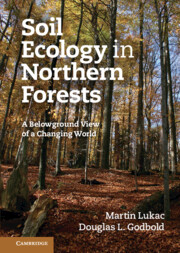Book contents
- Frontmatter
- Contents
- Preface
- 1 Introduction
- 2 Soil properties
- 3 Forest soil development and classification
- 4 Soil fungi
- 5 Soil water
- 6 Forest carbon cycle
- 7 Nutrient cycling
- 8 Northern forests in a high-CO2 world
- 9 Soil acidity and heavy metal pollution
- 10 Nitrogen
- 11 Soil functioning and climate change
- References
- Index
- Plate section
11 - Soil functioning and climate change
Published online by Cambridge University Press: 26 April 2011
- Frontmatter
- Contents
- Preface
- 1 Introduction
- 2 Soil properties
- 3 Forest soil development and classification
- 4 Soil fungi
- 5 Soil water
- 6 Forest carbon cycle
- 7 Nutrient cycling
- 8 Northern forests in a high-CO2 world
- 9 Soil acidity and heavy metal pollution
- 10 Nitrogen
- 11 Soil functioning and climate change
- References
- Index
- Plate section
Summary
Forest ecosystems are experiencing a change in both the physical and the chemical environment. The physical changes are the changes in temperature, humidity and precipitation expected to occur with increased global warming; the chemical changes are increases in acidity and N deposition, as well as the effects of changes in the atmosphere such as elevated atmospheric CO2, and increased levels of near-ground ozone. As discussed in the previous chapters, many of these changes have been occurring over the past 100 years, for example soil acidification, but continue to leave a lasting legacy. Changes in gases in the atmosphere such as CO2 and O3 can be predicted; however, other changes such as temperature and precipitation on a local or regional scale are event-driven, an example being the heat wave and drought experience in Europe in 2003, which greatly reduced NPP on a sub-continental scale. Added to the unpredictability of many of these changes are the unknown interactions between many of these factors. Even if scientific understanding of physical and chemical climate change factors on forest ecosystems has greatly increased for single factors, the possible interactions have mostly not been investigated. The effects of these climate change parameters on biotic stress, such as insect damage, pathogenic fungi and bacteria, are largely unknown, and at best purely observational.
Climate change factors can also erode ecosystem stability. The stability of ecosystems is defined in terms of resistance and resilience (Peterson et al.1998).
- Type
- Chapter
- Information
- Soil Ecology in Northern ForestsA Belowground View of a Changing World, pp. 213 - 237Publisher: Cambridge University PressPrint publication year: 2011



